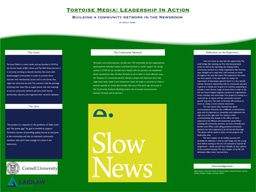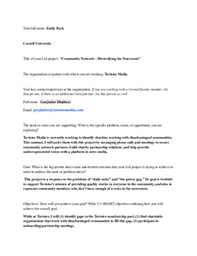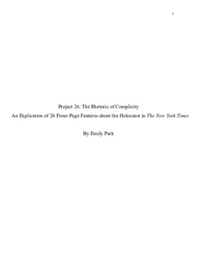Leadership in Action: Diversifying the Newsroom at Tortoise Media
Chapter 1: Arrival/Settling In
The thing that struck me most about London was its people. First, the sheer number of them––they swarm the sidewalks, gather on street corners, and flow in the endless sweaty tides of the tube station. Then, their diversity—these crowds comprise people from all walks of life. And finally, for the most part, their kindness––harried Americans need only ask a local Brit for directions, and the Brit will all but fly you there.
I arrived in London after a twelve-hour flight from San Diego, sleepless, hair plastered to my face, and yet more energetic and excited than I’d been in months. Our hosts welcomed my fellow Laidlaw housemate and me with a delicious Indian meal, something I’d always heard London was famous for. Then we fell promptly asleep. Just two days later, we took off for another adventure, traveling by train to volunteer at the KITE festival, where we spent three days camping near Glastonbury and helping facilitate workshops and live podcast tapings on diversity, democracy, and leadership.
When the festival was over, we returned to London and began working in the Tortoise Media office. Our team of five Laidlaw interns–or “associates,” as our manager generously calls us–began working on a project called Community Audience Build. Initially, we had two goals: (1) to expand Tortoise’s community network in order to include more diverse voices in the news, especially those from underserved communities, and (2) to find seek out worthy community members who could not afford news memberships and provide them with a whole year of free access to Tortoise’s innovative journalism.
Our community partners include over 100 community service organizations, from homeless shelters and food kitchens to career support for young women in STEM. As we work more closely with the partners, we will establish better connections that will allow us to serve them in more effective ways. For instance, if a community partner shares a unique and important story that might never make it into mainstream news, we sometimes create a podcast episode or article that includes the story. One early sign of success in this Community-Audience-Building project is increased communication between Tortoise and its partners.
Chapter 2: Obstacles/Challenges
After spending the first days of work camping in the middle of nowhere, the first days in the Tortoise office seemed pretty comfortable. Everyone was very kind and welcoming. There is a clear delineation between the higher-ups and the newcomers — but this makes sense, as some of the journalists have worked for some pretty big news organizations.
Interning for a news company also entails reading, listening to, and editing a fair bit of news. Sometimes I am asked to transcribe and edit podcasts. Most recently, I was shocked to discover stories of women being abused online. Because these kinds of stories seem so unreal or movie-like, the psychological implications are grossly overlooked. Another discovery came when I started working on podcast transcriptions and was assigned to one called “Visible Women” about the gender-data gap. One episode detailed how women are overlooked or mistreated in hospitals given a comparative lack of understanding about the female body (because most medical testing is done on male animals).
These stories inspire us to reach out to communities that are underrepresented in our Community Network. For instance, we have noticed a trend of education-based organizations joining our team, but we lack representation from LGBTQ+ and women’s organizations. Tortoise is a close-knit and well-run organization, so there aren’t many stressful challenges within the office culture, but there are countless external challenges that Tortoise hopes to bring to light. In this way, Tortoise demonstrates an innovative form of leadership — by bravely jumping into an unconventional form of newscasting and storytelling, they’re paving the way for a more democratic and diverse newsroom, and by extension, a more empathetic and connected community.
Does this all sound too good to be true? I thought so–until I started working with the team at Tortoise. To borrow Laidlaw’s framework, Tortoise has catapulted the news scene from asking “what” to asking “so what” and even “now what”! From community-building to podcast-editing, each new project has taught me a little bit more about what leadership means to the Tortoise team.
Chapter 3: Surprises/Growth
During these first four weeks at Tortoise, I have been surprised by a few things. The first is the openness of the teams (in charge of partnerships, business, and journalism) to teaching interns. For instance, I’ve continued working with the podcast team and have learned a lot about the inner workings of the studio. When a podcaster needed a short voice-over, she asked me to come in and provide an American voice for a bit of narration! She also showed me around the studio and taught me about the switch panels and audio editing/recording. The community network and partnerships team is equally welcoming and instructive. Sophie Fenton has introduced us to many education-based community partners and we are currently writing/editing email copy to be sent out at the beginning of the school year.
It’s hard to say exactly how this work is “changing” me. Transformation becomes most clear in retrospect. I will address this question in more depth in the final reflection. If pressed to elaborate, I’d say that the experience as a whole – which includes international travel, independent exploration, and teamwork at Tortoise – has made me more knowledgeable about the world and about how much work must be done to make media more equitable and diverse. I expected some version of the first change; any new experience of this magnitude is bound to have (or should have) some effect. But the second one — learning about how much work there is to be done in the media industry, and what Tortoise does behind the scenes – is a continuous process.



Please sign in
If you are a registered user on Laidlaw Scholars Network, please sign in